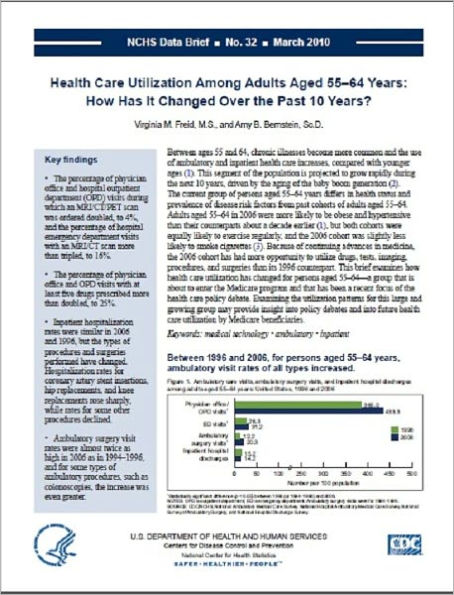Health Care Utilization Among Adults Aged 55–64 Years: How Has It Changed Over the Past 10 Years?
Between ages 55 and 64, chronic illnesses become more common and the use of ambulatory and inpatient health care increases, compared with younger ages (1). This segment of the population is projected to grow rapidly during the next 10 years, driven by the aging of the baby boom generation (2). The current group of persons aged 55–64 years differs in health status and prevalence of disease risk factors from past cohorts of adults aged 55–64. Adults aged 55–64 in 2006 were more likely to be obese and hypertensive than their counterparts about a decade earlier (1), but both cohorts were equally likely to exercise regularly, and the 2006 cohort was slightly less likely to smoke cigarettes (3). Because of continuing advances in medicine, the 2006 cohort has had more opportunity to utilize drugs, tests, imaging, procedures, and surgeries than its 1996 counterpart. This brief examines how health care utilization has changed for persons aged 55–64—a group that is about to enter the Medicare program and that has been a recent focus of the health care policy debate. Examining the utilization patterns for this large and growing group may provide insight into policy debates and into future health care utilization by Medicare beneficiaries.
1113644116
Health Care Utilization Among Adults Aged 55–64 Years: How Has It Changed Over the Past 10 Years?
Between ages 55 and 64, chronic illnesses become more common and the use of ambulatory and inpatient health care increases, compared with younger ages (1). This segment of the population is projected to grow rapidly during the next 10 years, driven by the aging of the baby boom generation (2). The current group of persons aged 55–64 years differs in health status and prevalence of disease risk factors from past cohorts of adults aged 55–64. Adults aged 55–64 in 2006 were more likely to be obese and hypertensive than their counterparts about a decade earlier (1), but both cohorts were equally likely to exercise regularly, and the 2006 cohort was slightly less likely to smoke cigarettes (3). Because of continuing advances in medicine, the 2006 cohort has had more opportunity to utilize drugs, tests, imaging, procedures, and surgeries than its 1996 counterpart. This brief examines how health care utilization has changed for persons aged 55–64—a group that is about to enter the Medicare program and that has been a recent focus of the health care policy debate. Examining the utilization patterns for this large and growing group may provide insight into policy debates and into future health care utilization by Medicare beneficiaries.
1.99
In Stock
5
1

Health Care Utilization Among Adults Aged 55–64 Years: How Has It Changed Over the Past 10 Years?

Health Care Utilization Among Adults Aged 55–64 Years: How Has It Changed Over the Past 10 Years?
eBook
$1.99
Related collections and offers
1.99
In Stock

Product Details
| BN ID: | 2940013874466 |
|---|---|
| Publisher: | The Delano Max Wealth Institute, LLC. |
| Publication date: | 12/12/2011 |
| Sold by: | Barnes & Noble |
| Format: | eBook |
| File size: | 1 MB |
From the B&N Reads Blog
